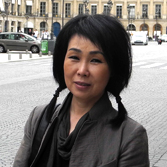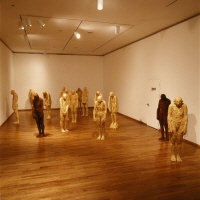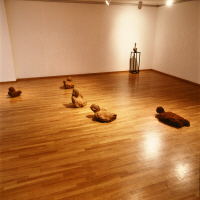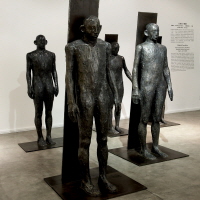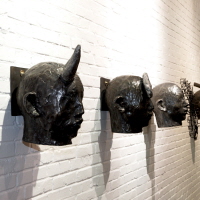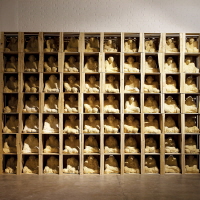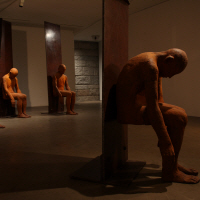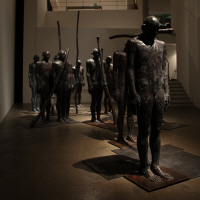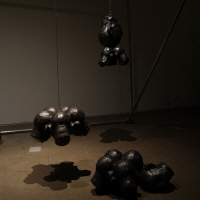Find Me in the Forest of People
A person kneeling down, a person immersed in a deep meditation with his large hands put on his legs crossed, the people trapped in a narrow and small space like us, and the people half-standing with a yoke-like long and heavy iron plate on their backs. Are all of them the beings burdened heavily with the weight of existence? Or are they the heroes who are engaged in a solitary and hard struggle with themselves to transcend the heavy burden?
In the group images created by Bae Hyung-Kyung, we cannot find any sign indicating or reminding us of certain persons. Their hairs are cut all, and moreover, they are too blunt for us to recognize their state of mind. The blunt figures lack of a sense of motion mostly. Since any detailed description is excluded, they may look like the human forms reduced to a lump. The rough matiere of the surface and the solid forms both showing the artist's hand pressure and its traces seem to be the results of condensing the figures into a lump, not the results of lacked dynamics. So, in her molded works, the mass is distanced gradually from representation instead of being protruded forwards, despite the forms as a lump have the human looks. Hence, Bae Hyung-Kyung's molded works are reminiscent of Auguste Rodin's
When such portrait sculpture made of gypsum was presented to their client 'French Writers' Association,' it is said that many people were too amazed with them. At that time, the French writers jeered and sneered at the lump like 'a cocoon' by saying "a nameless and coarse lump" or "a huge fetus."
It was Rainer Maria Rilke or Rodin's assistant who had found a creativity in Rodin. Rilke could read 'freedom of creation, pride of creation and luxuriant ecstasy and intoxication' in his master's work. As Rosalind Krauss mentioned,
The descriptiveness relying on the representations affected by the degree of emphasizing the matiere revealing the properties of the materials in sculpture recedes but instead, the matiere of the surface emerges up. Bae Hyung-Kyung's forms as a lump are positioned just at this point. However, the human forms expressed by her are characterized most by anonymity. While Michelangelo's or Rodin's works represent certain figures, Bae Hyung-Kyung has no particular models. The anonymity in her art works is fundamentally based on the motif of a muscular male body, but it is more intensified due to the basic forms with their gender not distinguishable. Such imperfect forms are the elements highlighting 'aesthetics of imperfection' in her works. They also inform us that the works are in the process of being produced. However, her works do not only reveal a lump as a material. Her figure images near the Expressionism sculpture in the context of forms are full of primitive energy and mental aura. They are grouped, but ultimately, each of them cannot but be alone. The lump resembling the human beings evokes a sense of massive silence. Her works trapped in the forest of people but revealing an existential loneliness more than the relationship are not reminiscent of the Buddha images but characterized religiously by the wisdom of silence. So, in order to understand her works, we need to be aware of the fact that we can hardly find such shadows of human emotion as pain, despair, anger, conflict or alienation. That her works render a mood of the time stopping its motion to be condensed may be the result of her will to proceed toward something.
The people crouching in a small alcove made of the wooden cartons seem to symbolize the hermits self-exiled from the real world. Or, do they symbolize Guru who entered into the snow-covered Himalaya mountains in order to cut the chain of 'Sams' and transcended existence and even the flow of time? Otherwise, do they symbolize Bodhi-dharma who reached 'Sunyata' after all the 9-year-long practice of asceticism facing the wall? The figures sitting in the boxes stacked remind us of the bodhisattvas' images enshrined in the main room of Seokgulam. In addition, since frontality is emphasized in the figures reminiscent of a Buddhistic ideogram, it is quite natural for us to be reminded even of the human-size Buddha statue. Frontality matches something monumental and particularly, the forms implementing some religious theme better than some aesthetic themes. Usually, the art works pursuing some religious themes tend to have certain epic structures even if they should mobilize such rhetorics as symbolism or metaphor. However, it is deemed originally impossible for us to find some descriptiveness in her works. Because we have already been used to the religious ideograms, we can hardly be reminded of such ideograms by her works. Nevertheless, the fact that the hands are unusually highlighted to be larger than other parts of the body may drive us into the guess that the figures may be not ascetic Buddhist monks but the laborers. But they may be neither monks nor laborers. For they are a group of the forms numerously reproduced through self-multiplication.
Now, we need to determine what the artist want to talk about by examining the characteristics of her works. As discussed above, her works may well be characterized by anonymity, imperfection and frontality. In addition, it is important to note that lump and superficial matiere are emphasized more than the detailed depiction. Such characteristics act as the factors urging us to accept her works as religious, but it is apparent that she does not attempt to express the doctrines or creed of a certain religion. Anyway, her works show us a process of being generated and changed rather than something perfected. So, it is not wrong to say that the dynamic aesthetics deemed important in the aesthetics of imperfection is an important element of her works.
Nevertheless, we cannot remove from her works the laborious struggle with her ego for victory of the mind or meditation and transcendency. What she wants to herald a message through her works is not about achievement of an absolute but about ourselves as subjects struggling for the achievement. Furthermore, it is not exaggerating to say that she expresses her own self-portrait in her works.
Choi Tae-man(art critic)
Bae Hyung Kyung
It is precisely 2 decades since Bae Hyung-kyoung held her first solo exhibition. This year, too, her subject is the human body. Neither female nor male. The form is just 'the body.' Like a medical copper body designed to be faithful to the concept, her human forms look like a typical but anonymous being rather than social or existential. Nevertheless, since her human forms feature a male body with strong shoulders and muscles, they are the human bodies on the boundary between masculinity and femininity. The social question about the human existentialism seems to be equated with the personal question about femininity and its roles. Furthermore, the forms with a horn on the head, a part of head decomposed or even an object disorderly in front of one-side face shape the pain welling up from within the inside. The adolescent girls will be gradually used to their physical pain occurring from within their inside body, and so, their perception of the human body must not be the same as boys'. Hence, her human body becomes herself. With such 'verb' type themes as 'Look' or 'Think,' her works reinforce subjectivity of the behaviors only to prove such guess.
The human body she expresses has obscure eye-balls and fluid surface. The skin full of her hand traces seems to be dragging down, and the narrow parts around the eyes seem to form the cheeks, while the nose rises high. Such fluidity implies the flow of time and the variability. All such under-definition is the present the artist looks at. A long and thick iron plate is fixed into the human body. The human body keeps it life-long like its shadow. It does not feel its weight but its form should stay captured in a place. The mechanism symbolizes 'Karma.' Her work titled 'Think' features the rough hand traces and the nose only within a square box. It is reminiscent of 'Arhat' statue or self-mortifying Buddha statue. Her solo exhibition in 2001 was titled 'Resembles Buddha,' and that in Beijing in 2009 was titled 'Karma.' The two exhibitions hint a meditation on life from the Buddhistic perspective, and her solo exhibition in 2004 titled 'Man Is Born to Live and Then, Die' can be reviewed in the same context, although the title might be not of a religious nature. Anyway, she looks into human life and mentality, being detached from afar. She expresses the extremely self-reflecting mediation on being from the Buddhistic perspective.
She respects tradition, pursues a naturalism formative grammar and maintains a self-reflecting view of the human life. She is a rare artist who has insisted on a single theme consistently to find an answer to the question she raised for herself.
Jo Eun-jeong






